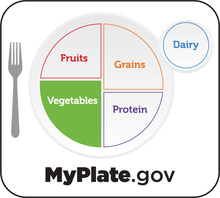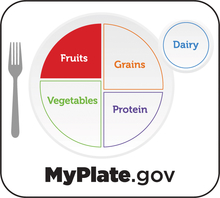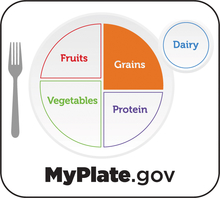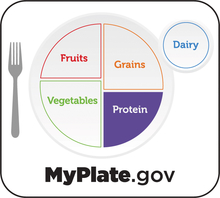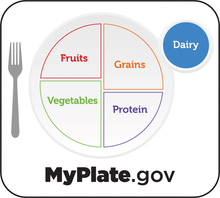Dietary guidelines
The goal of the Dietary Guidelines for Americans (DGAs) is for individuals throughout all stages of the lifespan to have eating patterns that promote overall health and help prevent chronic disease.
What can you do? The foods and beverages you consume in combination make up your eating pattern. This pattern is more than the sum of its parts (individual foods and nutrients) – all foods and beverages consumed act together in relation to health. Core concepts and recommendations are:
- Follow a healthy eating pattern across the lifespan.
- Focus on variety, nutrient density and amount.
- Limit calories from added sugars and saturated fats and reduce sodium intake
- Shift to healthier food and beverage choices.
- Support healthy eating patterns for all.
Healthy eating patterns:
- Include more fruits, vegetables, whole grains and healthy oils.
- Limit the amount of saturated and trans-fats, added sugars and sodium.
- Choose a variety of nutrient-dense foods in recommended amounts.
- Balance your food intake with physical activity.
MyPlate
Follow MyPlate: The guide to building healthy eating patterns by making healthy choices across the food groups every day. Remember to make half your plate fruits and vegetables.
Vegetables:
Include a variety of cooked or raw vegetables, fresh, frozen, dried, and canned, from the following subgroups:
- Dark green.
- Red and orange.
- Beans and peas.
- Starchy, and other.
Fruits:
Include a variety of cooked or raw fruits, fresh, frozen, dried and canned:
- Whole fruit.
- Canned -- pick lower sugar.
- 100 percent fruit juice.
- Frozen -- pick lower sugar.
Grains:
Choose whole grains (listed as the first ingredient in the ingredients list) and limit refined grains. Whole grain foods can be:
- Rice, oatmeal, popcorn.
- Whole grain ingredients in breads, cereals, crackers and pasta.
Protein:
Mix up your protein choices by including both plant and animal sources of protein. Pay attention to portion size and select from these subgroups:
- Meats, seafood and poultry.
- Legumes (beans and peas).
- Eggs.
- Nuts and seeds.
- Soy products.
Dairy:
Milk, milk products, and soy beverages fortified with calcium, vitamin A, and vitamin D are included for their content of calcium, phosphorus, Vitamins A & D, riboflavin, vitamin B12, protein, potassium, zinc, choline, magnesium, and selenium. Other dairy substitutes contain calcium but are lower in other nutrients.
- Low-fat milk.
- Lower-fat cheese.
- Low-fat yogurt.
- Fortified soy dairy products.
Reviewed in 2021



